Excerpts from Jim Conrad's
Naturalist Newsletter
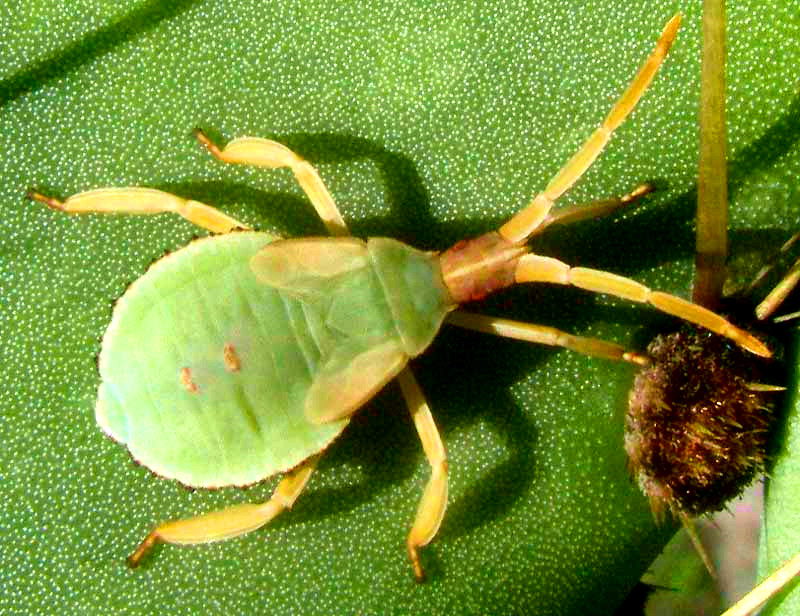
from the October 13, 2013 Newsletter issued from the Frio Canyon Nature Education Center in the valley of the Dry Frio River in northern Uvalde County, southwestern Texas, on the southern border of the Edwards Plateau; elevation ~1750m (~5750 ft); N29.62°, W99.86°; USA
PRICKLYPEAR BUG
I was botanizing with a friend when we spotted an insect on a pricklypear cactus. It was an immature bug, a nymph, and I'm using the word "bug" in its more technical sense, referring to a member of the True Bug Order, the Hemiptera. Above, you can see the nymphal bug with its hardly developed wings but very large, unusual antennae, wandering across a pricklypear pad.
While snapping the above picture I told my friend that our volunteer bug identifier, Bea in Ontario, would be tickled to see such a singular-looking bug. My friend replied, having no idea what the bug's identity might be, "Watch the common name turn out to be Pricklypear Bug... "
That's exactly what happened. Our picture shows a Pricklypear Bug, CHELINIDEA TABULATA, found from Texas and California south through Mexico and Central America into northern South America. In Australia it's been introduced as a biological control agent in an attempt to control American pricklypears who have escaped and become serious weeds.
The Pricklypear Bug isn't to be confused with the Cactus Bug we saw earlier.
Nymphs of that somewhat-closely-related species are bright red and they tend to cluster in groups, while our nymph not only is green but also ranged all alone on his pricklypear. These are consistent behavioral differences between the two species.
entry dated March 25, 2023, issued from near Tequisquiapan; elevation about 1,900m, (6200 ft), ~N20.57°, ~W99.89°; Querétaro state, MÉXICO
(~N20.55°, ~W99.89°)
BUG DAMAGE ON CACTI
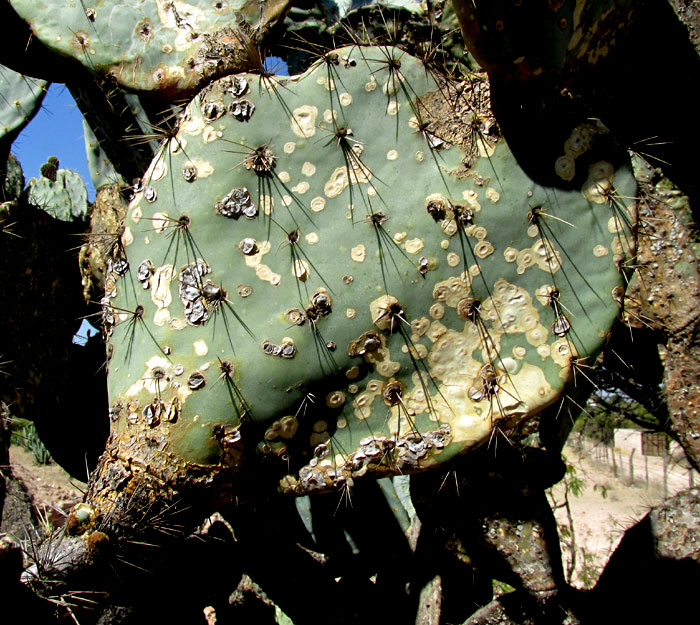
Many pricklypears here are covered with white, circular spots such as the above on Opuntia streptacantha. On this 3m tall (10ft) individual, the spots were concentrated in certain parts of the cactus, while parts of the same individual had none. Some nearby individuals of the same species displayed no such spots at all.
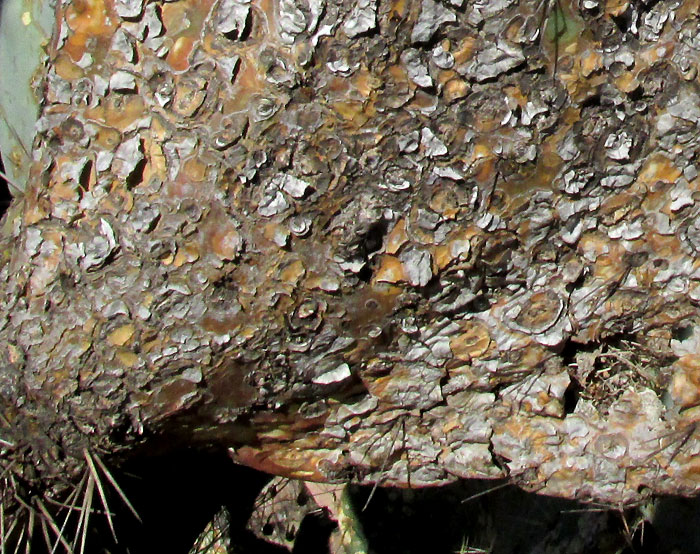
The surfaces of older pads toward the cactus's base occasionally were completely covered with coalesced spots, as shown above. In the above picture, at the lower, right corner, notice where the cactus's tissue has withered, leaving interior veins exposed. The coverings of many spots are unattached on one side, giving the impression that an insect larva might have emerged from the spot, to metamorphose. The literature later indicated, however, that that wasn't the case. Nymphs emerge from eggs probably deposited on spines.
In this area, while the above Opuntia streptacantha seems to be the most frequently damaged, Opuntia engelmannii var. cuija can also suffer massive damage.
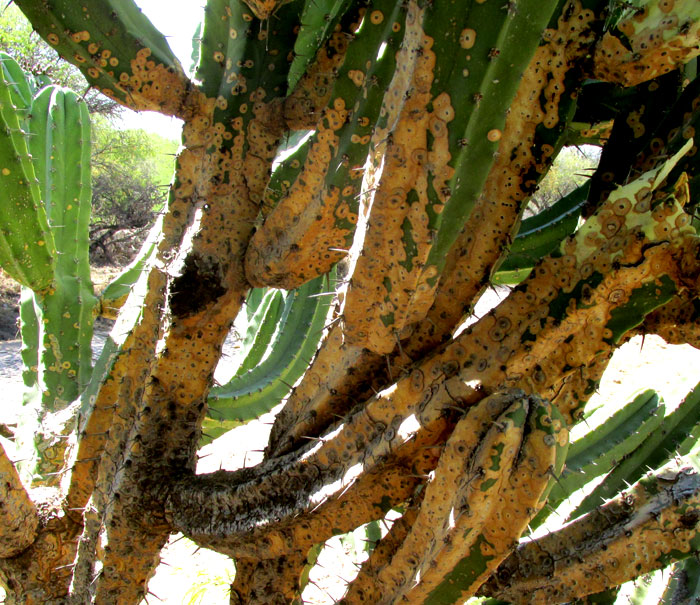
Moreover, pricklypears aren't the only cacti here afflicted with white spots. Above you can see the same kind of spots on Myrtillocactus geometrizans, also common in this area.
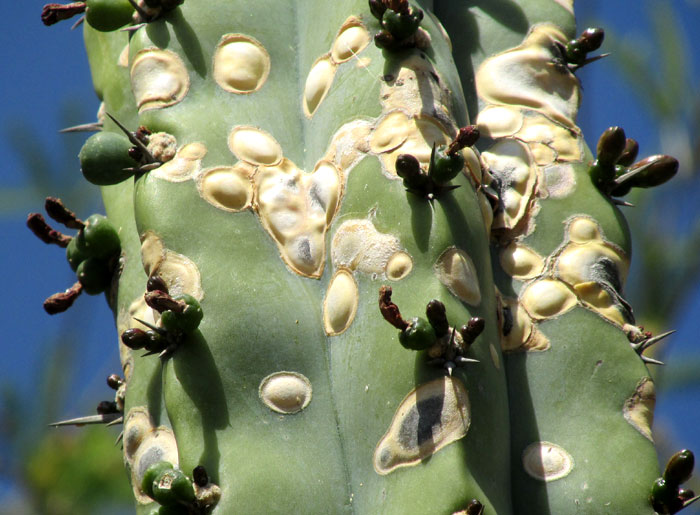
Up closer, the spots are like blisters, suggesting that maybe larvae inside them, but they're empty.
Growing pricklypears is big business in this area, for they're used both for their edible fruits and the edible pads of certain species. Therefore, plenty of information is available about diseases afflicting them. Based on that literature, the white spots shown above appear to be made by pricklypear bugs, genus Chelinidea, belonging to the True Bug order Hemiptera. True bugs insert their strawlike proboscises into plant tissue and suck up sap. Cicadas, aphids, planthoppers and stinkbugs are hemipterids.
Pricklypear bugs damage pricklypear in North America, too. There, as well as northern Mexico, the main species doing such damage is Chelinidea vittiger, but -- according to current CBIF distribution maps -- in this part of upland central Mexico, the main species documented is Chelinidea tabulata. So, I'm filing this page under CHELINIDEA cf. TABULATA, the "cf." meaning "confirm," which I hope to do when the bugs start appearing.
The GBIF distribution map for Chelinidea tabulata clearly shows where our bug has been documented. Other than that, there's little information on this species. However, there's plenty available about North America's commonly occurring Chelinidea vittiger. The 1912 USDA Bureau of Entomology Bulletin No. 113 entitled The Principal Cactus Insects of the United States, by W.D. Hunter and others, tells us that the small, circular discolorations on the cactus joints don't appear until Chelinidea vittiger has been feeding for some time.
The authors further write that "As the injury proceeds, the spots become larger and coalesce, so that the whole area of the epidermis assumes a deadened, yellowish, and pitted appearance" -- a description fairly matching what our pictures above show. They say that the cactus plant is weakened and may fall down, though if the attack isn't great, some of the fallen pads may root and form new plants. I've often seen that here. More frequently, however, "... the joints are unable to recuperate and either dry up completely or become the breeding places for many species of scavenger insects found associated with the cactus plant."
With regard to the fallen pads starting new plants, and the many species of scavenger insects associated with the fallen pads, one wonders whether these may not be adaptations that benefit not only the long-term survivability of the species, but also of the community of which the afflicted plants are members. Not only could the fallen pads help the cactus propagate, but also the fallen parts would enrich the soil with their contributed organic matter and nutrients, to the benefit of all. Perhaps the encouragement of many species of scavenger insects similarly benefits the whole community. In 1912 when the above Bulletin No. 113 was published, people didn't think like that, but it's being found that evolution is much more complex and focused on long-term sustainablity than we ever imagined before.